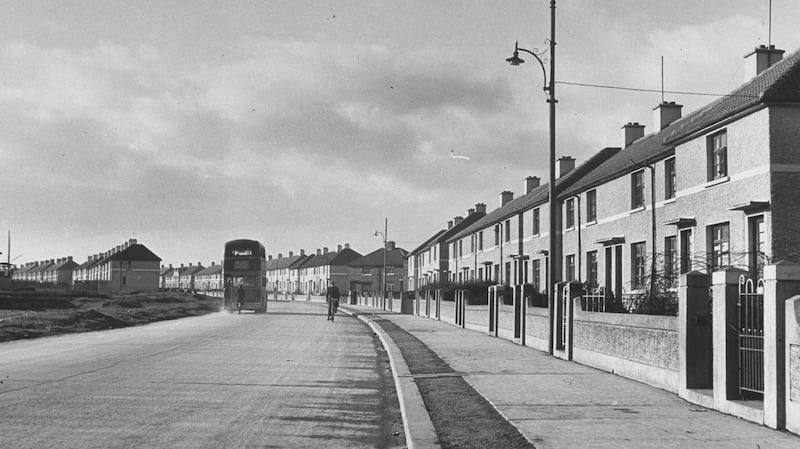The other day, I was passing a building site in Dublin. The hoarding, like hundreds of others around burgeoning Heights and Parks and Groves, announced the imminent arrival of a “contemporary apartment community”.
A mad thought came to me. What if I crept up in the night like Banksy or Maser, blotted out “apartment” and wrote in a shocking four-letter f-word: “flat”?
The words are technically synonymous, after all. The Oxford English Dictionary defines "apartment" as "Chiefly North American . . . corresponding to flat in British use." But there are no flats being built in Ireland anymore – only apartments.

Apartments are for People Like Us. Flats are dodgy, dated, dangerous – and lower class
This is the second most interesting linguistic shift in the last few decades and it happened, I think, in parallel with the first: the verbal sleight-of-mouth of the 1990s when “debt” was magically transformed into its opposite: “credit”.
The simplest explanation for the rise of the apartment and the levelling of the flat is mere snobbery, with the former sounding posher than the latter. But it doesn’t hold water: Tite Street, the most expensive place to live in London, still has “flats”.
On the weekend I was born in 1958, there were 41 small ads in The Irish Times offering a place (other than a house) to rent in Dublin. Not one was described as an apartment. Twenty-five were called flats or flatlets. (The rest were bedsits or unspecified.)
These flats were in highly desirable and respectable areas of the city (this was The Irish Times, after all): Merrion Square, Rathmines, Rathgar, Ballsbridge, Waterloo Road, Dún Laoghaire. “Flats” did not carry a particular connotation of social class: urban workers lived in flats, but so did students and solicitors and matrons and dowagers.
“Flats” had indeed replaced a much less desirable term: tenements. In Dublin (though not in cities like Edinburgh where tenements are still highly respectable), the flat was, contrary to its name, a step up.
But search the Irish Times property supplement today and you won’t find a single flat, just scores of apartments. Where you will find flats, however, are in court reports and tales of squalor: “dated and rundown flats”; “crime and destitution in the flats”; “attacked and stabbed in the flats complex”; “locked up in two-room flats with no balconies and damp running down the walls”.
In a report from November last, there is even a literal replacement of bad flats by good apartments. We have “the proposed development of more than 1,000 apartments” on the site of the former “O’Devaney Gardens flats”.
So, in Ireland (but not elsewhere), there has been a very effective semantic sorting. Words that used to mean the same thing (the heading on the old Irish Times small ad section was “Apartments and Flats to Let”) have been sharply differentiated. Apartments are for People Like Us. Flats are dodgy, dated, dangerous – and lower class.
This kind of linguistic remould doesn’t happen without a purpose. The purpose is surely one of consolation and compensation: yes, you have to settle for an overpriced apartment, but it could be worse – it could be a flat.
Developer-led planning, with inadequate provision for shared spaces, has put the 'apart' into apartment
Most Irish people still really want a house. For all sorts of cultural and historical reasons, “home” and “house” are still virtually synonymous in the Irish mind.
In studies for the Housing Agency, people in houses were twice as likely as those in apartments to report being satisfied with where they were living. A lot of this has to do with the Irish hankering for security – houses are much more likely than apartments to be owned by their occupiers.
But a lot of it also has to do with that word on the hoarding I passed: community. As the Housing Agency study reported: “Despite living closer together in apartment schemes, people felt further apart than in the traditional housing most had grown up in. They felt living in an apartment made it more difficult to meet neighbours and forge friendships.”
Developer-led planning, with inadequate provision for shared spaces, has put the “apart” into apartment. The “contemporary apartment community” is a marketing slogan but seldom a reality. The study says that “Short-term lettings and the increase of ‘corporate’ landlords were seen as having a negative impact, diminishing the sense of community.”
But cheer up – at least you don’t live in a flat or, worse still, a flat complex. Huge, profit-driven apartment schemes are not conducive to the creation of a local Us. So the language has shifted to provide the next-best thing: a Not Them. They live in flatland; we live in contemporary apartment communities.
The irony is that there was in fact a stronger sense of community in the old working-class flats. A friend of mine who taught in inner city Dublin recalls that in the early 1990s, Dublin City Council put railings and gates around some of the old flat complexes and installed keypads that required codes.
Her pupils who lived there were outraged: “They’re trying to turn the flats into apartments!” They were on to something.
When words are being manipulated, it is not to clarify meanings, but to obscure them. What is being disguised in this particular shift is the crying need to build, not flats or apartments or whatever we want to call them, but communities.











